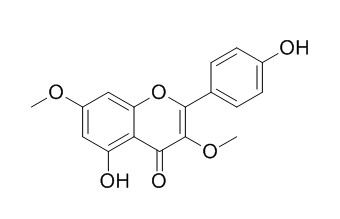Kumatakenin
Kumatakenin can suppress >80% of the SOS-inducing activity of Trp-P-1 at <0.06 micromol/mL.
Inquire / Order:
manager@chemfaces.com
Technical Inquiries:
service@chemfaces.com
Tel:
+86-27-84237783
Fax:
+86-27-84254680
Address:
1 Building, No. 83, CheCheng Rd., Wuhan Economic and Technological Development Zone, Wuhan, Hubei 430056, PRC
Providing storage is as stated on the product vial and the vial is kept tightly sealed, the product can be stored for up to
24 months(2-8C).
Wherever possible, you should prepare and use solutions on the same day. However, if you need to make up stock solutions in advance, we recommend that you store the solution as aliquots in tightly sealed vials at -20C. Generally, these will be useable for up to two weeks. Before use, and prior to opening the vial we recommend that you allow your product to equilibrate to room temperature for at least 1 hour.
Need more advice on solubility, usage and handling? Please email to: service@chemfaces.com
The packaging of the product may have turned upside down during transportation, resulting in the natural compounds adhering to the neck or cap of the vial. take the vial out of its packaging and gently shake to let the compounds fall to the bottom of the vial. for liquid products, centrifuge at 200-500 RPM to gather the liquid at the bottom of the vial. try to avoid loss or contamination during handling.
ACS Omega.2023, 8(36):32424-32431.
ACS Chem Biol.2019, 14(5):873-881
Advances in Traditional Medicine 2021, 21:779-789.
Srinagarind Medical Journal2017, 32(1)
Int J Mol Sci.2024, 25(12):6456.
Molecules.2019, 24(23):E4303
Nutrients.2019, 11(11):E2694
J Enzyme Inhib Med Chem.2019, 34(1):134-143
Revista Brasileira de Farmacognosia2021, 31:794-804.
Horticulture Research2020, 7:111.
Related and Featured Products
Herbacetin
Catalog No: CFN99778
CAS No: 527-95-7
Price: $338/20mg
8-Methoxykaempferol
Catalog No: CFN92382
CAS No: 571-74-4
Price: Inquiry(manager@chemfaces.com)
Prudomestin
Catalog No: CFN98453
CAS No: 3443-28-5
Price: $268/20mg
5,7-Dihydroxy-3,4',8-trimethoxyflavone
Catalog No: CFN99666
CAS No: 1570-09-8
Price: Inquiry(manager@chemfaces.com)
5,7-Diacetoxy-3,4',8-trimethoxyflavone
Catalog No: CFN98818
CAS No: 5128-43-8
Price: Inquiry(manager@chemfaces.com)
4',5,7-Trihydroxy 3,6,8-trimethoxyflavone
Catalog No: CFN70413
CAS No: 57393-71-2
Price: Inquiry(manager@chemfaces.com)
Calycopterin
Catalog No: CFN70374
CAS No: 481-52-7
Price: Inquiry(manager@chemfaces.com)
Araneosol
Catalog No: CFN98797
CAS No: 50461-86-4
Price: Inquiry(manager@chemfaces.com)
2',3,5,7-Tetrahydroxyflavone
Catalog No: CFN70373
CAS No: 480-15-9
Price: Inquiry(manager@chemfaces.com)
Kaempferol
Catalog No: CFN98838
CAS No: 520-18-3
Price: $30/20mg
J Agric Food Chem. 2000 Mar;48(3):642-7.
Antimutagenic activity of flavonoids from Pogostemon cablin.[Pubmed:
10725128]
A methanol extract from Pogostemon cablin showed a suppressive effect on umu gene expression of SOS response in Salmonella typhimurium TA1535/pSK1002 against the mutagen 2-(2-furyl)-3-(5-nitro-2-furyl)acrylamide (furylfuramide).
METHODS AND RESULTS:
The methanol extract was re-extracted with hexane, dichloromethane, butanol, and water. A dichloromethane fraction showed a suppressive effect. Suppressive compounds against furylfuramide in the dichloromethane fraction were isolated by SiO(2) column chromatography and identified as 7,4'-di-O-methyleriodictyol (1), 7, 3',4'-tri-O-methyleriodictyol (2), and 3,7,4'-tri-O-methylkaempferol (3). In addition, three flavonoids, ombuine (4), pachypodol (5), and Kumatakenin (6), were isolated and identified from the dichrolomethane fraction. Compounds 1 and 3 suppressed >50% of the SOS-inducing activity at <0.6 micromol/mL, and the ID(50) values of both compounds were 0.25 micromol/mL. Compound 2 showed a weakly suppressive effect (17%) at a concentration of 0.6 micromol/mL, and compounds 4-6 did not. These compounds were also assayed with 3-amino-1,4-dimethyl-5H-pyrido[4,3-b]indole (Trp-P-1), which requires liver metabolizing enzymes. Compounds 3,4,5,Kumatakenin (6) suppressed >80% of the SOS-inducing activity of Trp-P-1 at <0.06 micromol/mL, and compounds 1 and 2 suppressed 87 and 63% at a concentration of 0.3 micromol/mL. In addition, these compounds were assayed with activated Trp-P-1, and the suppressed effects of these compounds were further decreased when compared to Trp-P-1.
CONCLUSIONS:
The antimutagenic activities of these compounds against furylfuramide, Trp-P-1, and activated Trp-P-1 were assayed by the Ames test using S. typhimurium TA100.
Zhongguo Zhong Yao Za Zhi. 2014 Jul;39(14):2674-8.
A new flavonone from seeds of Alpinia katsumadai and its neuroprotective effect on PC12 cells.[Pubmed:
25272494]
A new flavonone, named as (2R, 3S)-pinobanksin-3-cinnamate(1), together with six known compounds, pinocem-brin (2), pinobanksin (3), 3-O-acetylpinobanksin (4), galangin (5), Kumatakenin(6), and 3-methylkaempferol (7), were isolated from a 95% ethanol extract of seeds of Alpinia katsumadai through a combination of various chromatographic techniques, including silica gel and Sephadex LH-20.
METHODS AND RESULTS:
The structure of compound 1 was elucidated by spectroscopic data analysis. Compound 1 exhibits a potent neuroprotective effect against the corticosterone-damaged PC12 cells, which may be underlying the effect by scavenging intracellular ROS.
Pharmacogn Mag. 2010 Oct;6(24):339-44.
Phytoconstituents from Alpinia purpurata and their in vitro inhibitory activity against Mycobacterium tuberculosis.[Pubmed:
21120040]
Alpinia purpurata or red ginger was studied for its phytochemical constituents as part of our growing interest on Philippine Zingiberaceae plants that may exhibit antimycobacterial activity.
METHODS AND RESULTS:
The hexane and dichloromethane subextracts of the leaves were fractionated and purified using silica gel chromatography to afford a mixture of C(28)-C(32) fatty alcohols, a 3-methoxyflavone and two steroidal glycosides. The two latter metabolites were spectroscopically identified as Kumatakenin (1), sitosteryl-3-O-6-palmitoyl-β-D-glucoside (2) and b-sitosteryl galactoside (3) using ultraviolet (UV), infrared (IR), electron impact mass spectrometer (EIMS) and nuclear magnetic resonance (NMR) experiments, and by comparison with literature data.
CONCLUSIONS:
This study demonstrates for the first time the isolation of these constituents from A. purpurata. In addition to the purported anti-inflammatory activity, its phytomedicinal potential to treat tuberculosis is also described.



